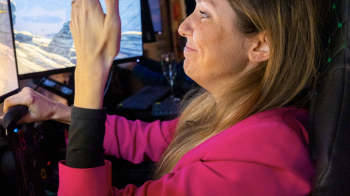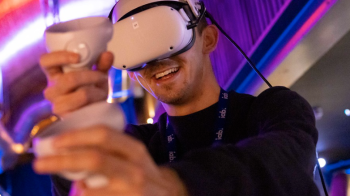Gaming Upfronts 2022: what we learnt
Posted on Friday 21 October 2022 | IAB UK
From measuring attention to gaming as a social connector, here’s what we took away from Gaming Upfronts
Opening our first IRL Gaming Upfronts at The Steel Yard, our CMO James Chandler told the audience that they would come away from the event “realising the huge potential that gaming has as a fully emerged and incredible channel to be utilised”. With sessions from Activision Blizzard Media, Anzu, Bidstack, Frameplay and Twitch, what followed was a fast-paced but insightful exploration of what gaming has to offer and where it’s headed next.
Shifting from viewability to attention
“How do we move towards attention rather than just view? I think gaming is poised to be one of the leaders on that”, said Bidstack’s Jude O’Connor - introducing a theme that would come up numerous times across the afternoon. With 3 billion gamers globally spending an average of 3-10 minutes with a game per session time, it’s clear that gaming is capturing and holding players’ attention. Yet when it comes to advertising, “there is still a huge disparity between eyeballs and ad spend”, explained Simon Jones, Managing Partner at Spark Foundry. “It’s incumbent on agencies to ensure they’re selling it in properly”, he said, adding that standardised measurement will help a lot (find the new Intrinsic In-Game Measurement Guidelines from the IAB here).
There is no ‘one’ gaming community
Amy Venier, SVP Supply Partnerships at Frameplay, highlighted the immersive nature of intrinsic in-game advertising. As she put it: “Brands and games share a connected ecosystem… in-game advertising does create that deeper value exchange [with players].” When it comes to how brands should be thinking about in-game audiences, Venier advised that they don’t think of gamers as just one homogenous group: “There is no one gaming community. There are thousands.” Brands need to appreciate the diversity within the gaming community in order to authentically resonate with players.
Shedding preconceptions of gamers
In a panel hosted by Anzu’s Senior Marketing Manager Caroline Manson, debate turned to how gaming is evolving and what work still needs to be done. In the past, gaming has been held back by preconceptions that its audience is “sweaty teenagers, but we’ve got over that stigma”, said Spark Foundry’s Scott Curtis, Global Head of Digital and Innovation. According to the panel - which also included IAS’s Michael Isaacs-Olaye and Anzu’s Chris Blight - robust measurement and standardisation are essential to encourage ad dollars into gaming and allow the channel to scale. As Blight said: “Viewability is a must, attention is taking it that bit further.” On what he’d like to see next in gaming, Isaacs-Olaye said: “As much testing and learning as possible.”
Gaming is a social connector
The social power of gaming was the basis of Activision Blizzard Media’s session, hosted by Jonathan Stringfield, VP, Global Business Research & Marketing. “One of the superpowers of gaming is that it allows for intimate socialisation without physicality”, he explained, pointing to the way that gaming brought people together during lockdowns. He added: “Effective marketing will always hinge on us knowing the needs of the gamer.”
To that end, Stringfield shared the results of Activision research, showing that over a third of gamers play for social aspects and 65% of those that play video games do so with others (either online or in person). He was then joined on stage by James Whatley, CSO at Diva Agency, who highlighted the fact that the term “gamer” is actually quite divisive as it denotes negative connotations: “We don’t talk about gamers, we talk about people that play games. Only a small minority of people identify as gamers.”
What brands need to know about Gen Z
The generational shift between Gen Z and Millennials - and how that is reflected in gaming - was the focus of Twitch’s session, presented by Lou Emmerson, the company’s UK Sales Director. She shared the results of research ‘Generation Twitch’, which explores how behaviours are shifting across the generational divide. Significantly, those dubbed Gen Z (aged between 10 and 25 years) value authenticity over curation, interactive communication, and inclusivity rather than exclusivity. When it comes to advertising on Twitch, Emmerson suggested brands embrace the ‘live’ nature of the platform in order to genuinely resonate with Gen Z consumers that value candour and spontaneity. She also urged brands to feature diverse voices in their activity, with 78% of Gen Z players agreeing that Twitch is a diverse community for all.
You can find out more about Digital Upfronts and upcoming events here.
Related content
Gaming Upfronts 2024: Receptiveness, interactive ads & engaging communities
Learn moreDebunking 9 myths about advertising in gaming
Learn moreWhy marketers should embrace gaming as the premium environment it is
Learn moreCTV & gaming projected to deliver over £4bn in annual digital ad spend by 2026
Learn more
Fast forward to 2030 with Futurescape
An in-depth exploration of the attitudes, innovations and media shifts that will shape the years ahead and redefine how we advertise by the turn of the decade


